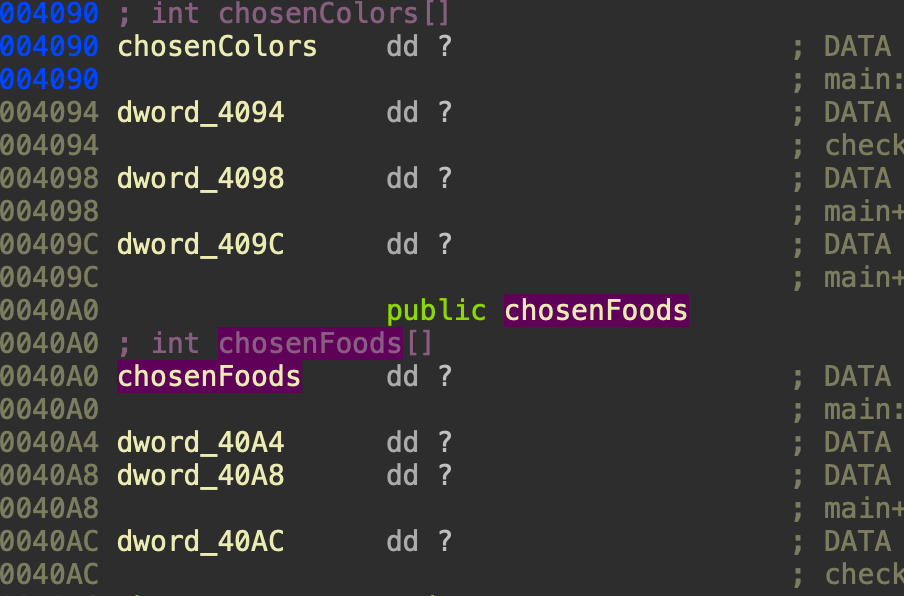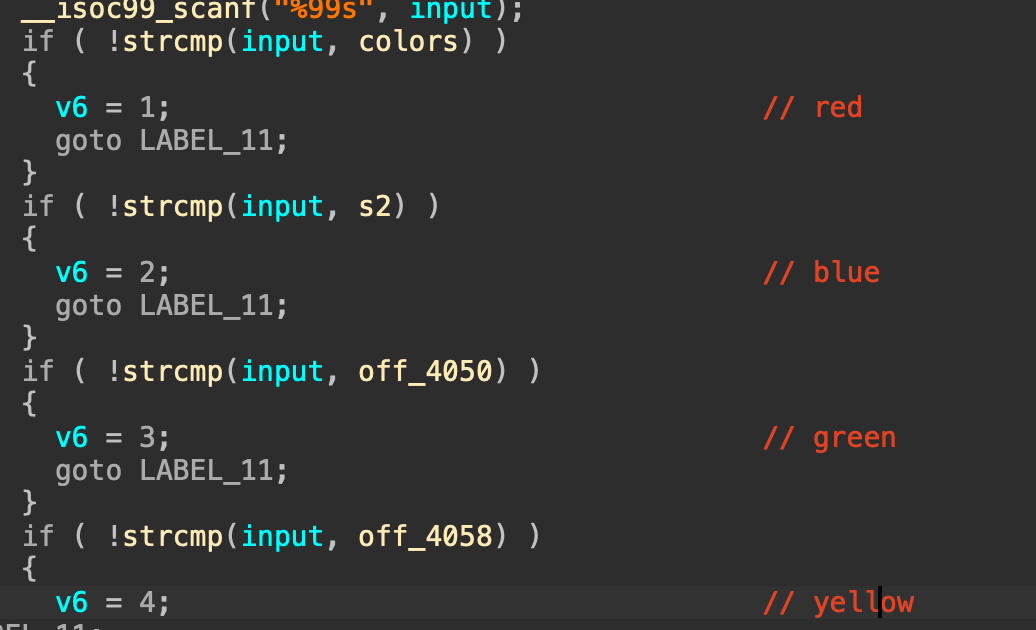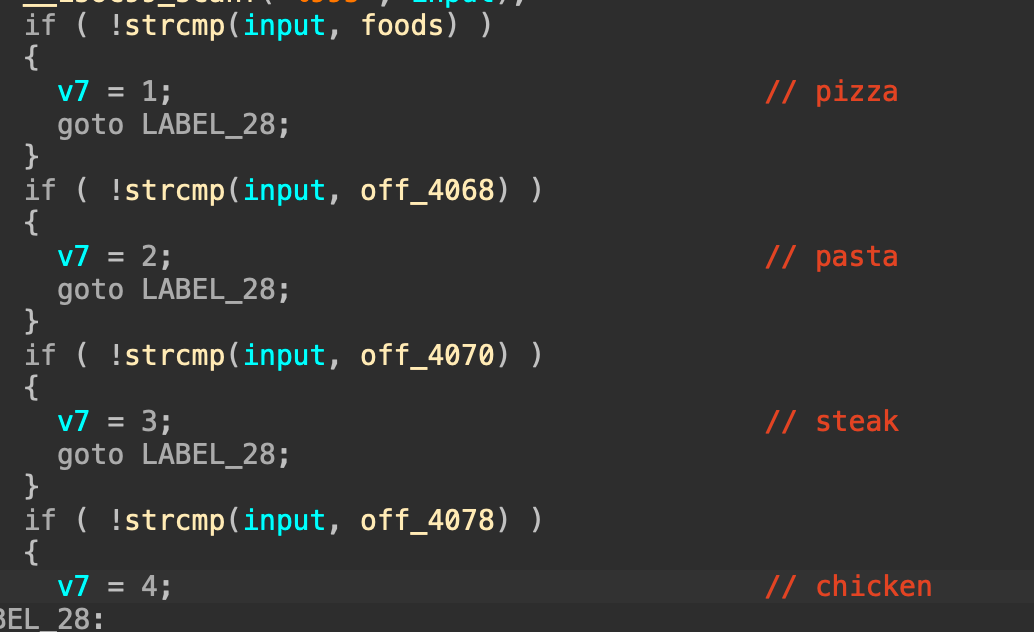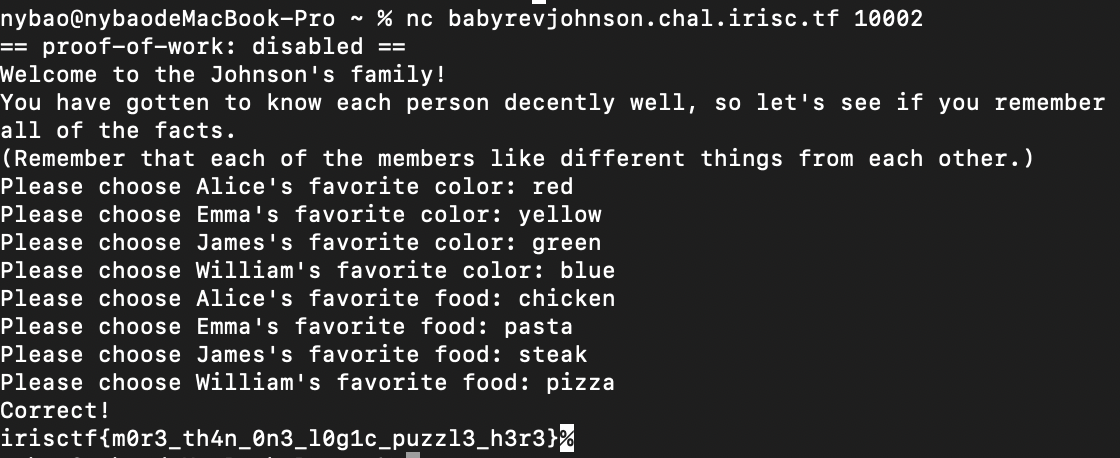
国际赛IrisCTF在前几天举办,遇到了一道有意思的题目,特来总结。

题目

附件如下:babyrevjohnson.tar
解题过程
关键main函数分析如下:
int __fastcall main(int argc, const char **argv, const char
**envp)
{
int v4;
int v5;
int v6;
int v7;
char input[104];
unsigned __int64 v9;
v9 = __readfsqword(0x28u);
puts("Welcome to the Johnson's family!");
puts("You have gotten to know each person decently well, so let's see
if you remember all of the facts.");
puts("(Remember that each of the members like different things from
each other.)");
v4 = 0;
while ( v4 <= 3 )
{
printf("Please choose %s's favorite color: ", (&names)[v4]);
4个人
__isoc99_scanf("%99s", input);
if ( !strcmp(input, colors) )
{
v6 = 1;
goto LABEL_11;
}
if ( !strcmp(input, s2) )
{
v6 = 2;
goto LABEL_11;
}
if ( !strcmp(input, off_4050) )
{
v6 = 3;
goto LABEL_11;
}
if ( !strcmp(input, off_4058) )
{
v6 = 4;
LABEL_11:
if ( v6 == chosenColors[0] || v6 == dword_4094 || v6 ==
dword_4098 || v6 == dword_409C )
puts("That option was already chosen!");
else
chosenColors[v4++] = v6;
}
else
{
puts("Invalid color!");
}
}
v5 = 0;
while ( v5 <= 3 )
{
printf("Please choose %s's favorite food: ", (&names)[v5]);
4个人最喜欢的食物
__isoc99_scanf("%99s", input);
if ( !strcmp(input, foods) )
{
v7 = 1;
goto LABEL_28;
}
if ( !strcmp(input, off_4068) )
{
v7 = 2;
goto LABEL_28;
}
if ( !strcmp(input, off_4070) )
{
v7 = 3;
goto LABEL_28;
}
if ( !strcmp(input, off_4078) )
{
v7 = 4;
LABEL_28:
if ( v7 == chosenFoods[0] || v7 == dword_40A4 || v7 == dword_40A8
|| v7 == dword_40AC )
puts("That option was already chosen!");
else
chosenFoods[v5++] = v7;
}
else
{
puts("Invalid food!");
}
}
check();
return 0;
}
-----------------------------------------------------------------------
将check提取出来,我们方便分析
其实到这里已经可以得到结果了,国外的题目确实很讲究趣味性,用颜色和食物作为导向,引导一步一步分析
笔者使用静态分析的方法,一步一步跟踪
C++
int check()
{
bool v0;
_BOOL4 v1;
_BOOL4 v2;
v0 = dword_40A8 != 2 && dword_40AC != 2;
v1 = v0 && dword_4094 != 1;
v2 = chosenColors[0] != 3 && dword_4094 != 3;
if ( !v2 || !v1 || chosenFoods[0] != 4 || dword_40AC == 3 ||
dword_4098 == 4 || dword_409C != 2 )
return puts("Incorrect.");
puts("Correct!");
return system("cat flag.txt");
}
-----------------------------------------------------------------------
对应的输入值地址如下:

我们将颜色color数组用x系列表示,将食物用food数组y系列表示
化简如下:
C++
v0 = y3 != 2 && y4 != 2;
v1 = v0 && x2 != 1;
v2 = x1 != 3 && x2 != 3;
if ( !v2 || !v1 || y1 != 4 || y4 == 3 || x3 == 4 || x4 != 2
)
{
}
else
{
}
-----------------------------------------------------------------------
思路1:简单粗暴的爆破,但不是学习的目的,因此并不采用
思路2:锻炼写脚本能力,使用z3解题可以锻炼写脚本的能力,因此采用
Python
from z3 import *
x1, x2, x3, x4 = Ints('x1 x2 x3 x4')
y1, y2, y3, y4 = Ints('y1 y2 y3 y4')
v0 = And(y3 != 2, y4 != 2)
v1 = And(v0, x2 != 1)
v2 = And(x1 != 3, x2 != 3)
cond = Or(Not(v2), Not(v1), y1 != 4, y4 == 3, x3 == 4, x4 != 2)
cond1 = Not(cond)
solver = Solver()
solver.add(cond1)
if solver.check() == sat:
model = solver.model()
print("成功:")
print("x1 =", model[x1])
print("x2 =", model[x2])
print("x3 =", model[x3])
print("x4 =", model[x4])
print("y1 =", model[y1])
print("y2 =", model[y2])
print("y3 =", model[y3])
print("y4 =", model[y4])
else:
print("无解")
---------------------------------------------------------------------------------------
得到结果
Python
成功:
x1 = 4
x2 = 0
x3 = 5
x4 = 2
y1 = 4
y2 = None
y3 = 3
y4 = 0
-----------------------------------------------------------------------
其实有经验的师傅发现了,这是有多解的,因为没有为约束变量添加范围约束
改进之后的代码如下:
Python
from z3 import *
x1, x2, x3, x4 = Ints('x1 x2 x3 x4')
y1, y2, y3, y4 = Ints('y1 y2 y3 y4')
v0 = And(y3 != 2, y4 != 2)
v1 = And(v0, x2 != 1)
v2 = And(x1 != 3, x2 != 3)
range_constraint = And(x1 >= 1, x1 <= 4, x2 >= 1, x2 <= 4, x3 >= 1, x3 <= 4, x4
>= 1, x4 <= 4,
y1 >= 1, y1 <= 4, y2 >= 1, y2 <= 4, y3 >= 1, y3 <= 4, y4 >= 1, y4 <= 4)
cond = Or(Not(v2), Not(v1), y1 != 4, y4 == 3, x3 == 4, x4 != 2)
cond1 = Not(cond)
solver = Solver()
solver.add(cond1)
solver.add(range_constraint)
if solver.check() == sat:
model = solver.model()
print("成功:")
print("x1 =", model[x1])
print("x2 =", model[x2])
print("x3 =", model[x3])
print("x4 =", model[x4])
print("y1 =", model[y1])
print("y2 =", model[y2])
print("y3 =", model[y3])
print("y4 =", model[y4])
else:
print("无解")
---------------------------------------------------------------------------------------
---------------------------------------------------------------------------------------
得到结果:
-----------------------------------------------------------------------
Python
成功:
x1 = 1
x2 = 4
x3 = 1
x4 = 2
y1 = 4
y2 = 1
y3 = 3
y4 = 4
-----------------------------------------------------------------------
发现x1和x3重复了,因此还要添加值不重复约束
Python
from z3 import *
x1, x2, x3, x4 = Ints('x1 x2 x3 x4')
y1, y2, y3, y4 = Ints('y1 y2 y3 y4')
v0 = And(y3 != 2, y4 != 2)
v1 = And(v0, x2 != 1)
v2 = And(x1 != 3, x2 != 3)
range_constraint = And(x1 >= 1, x1 <= 4, x2 >= 1, x2 <= 4, x3 >= 1, x3 <= 4, x4
>= 1, x4 <= 4,
y1 >= 1, y1 <= 4, y2 >= 1, y2 <= 4, y3 >= 1, y3 <= 4, y4 >= 1, y4 <= 4)
distinct_x=Distinct(x1,x2,x3,x4)
distinct_y=Distinct(y1,y2,y3,y4)
cond = Or(Not(v2), Not(v1), y1 != 4, y4 == 3, x3 == 4, x4 != 2)
cond1 = Not(cond)
solver = Solver()
solver.add(cond1)
solver.add(range_constraint)
solver.add(distinct_y)
solver.add(distinct_x)
if solver.check() == sat:
model = solver.model()
print("成功:")
print("x1 =", model[x1])
print("x2 =", model[x2])
print("x3 =", model[x3])
print("x4 =", model[x4])
print("y1 =", model[y1])
print("y2 =", model[y2])
print("y3 =", model[y3])
print("y4 =", model[y4])
else:
print("无解")
---------------------------------------------------------------------------------------
最终得到正确的结果
Python 成功: x1 = 1 x2 = 4 x3 = 3 x4 = 2 y1 = 4 y2 = 2 y3 = 3
y4 = 1
x1-x4= 1 4 3 2

y1-y4= 4 2 3 1

按照这样的顺序输入即可:

得到了flag
irisctf{m0r3_th4n_0n3_l0g1c_puzzl3_h3r3}

总结
题目并不是很难,没有复杂的ollvm混淆也没有复杂的加密。但是却一步一步引导我们去学习和总结。z3解题的过程中,会有很多误解,然后经过自己的思考总结,发现了漏掉的东西,再进行补充,最终写出正确的脚本。
国外的题还是很值得学习的,不单单为了出题而出题。这就是逻辑运算在z3的运用以及如何增加约束,让z3求解出我们需要的key。
本文作者:[email protected]
本文为安全脉搏专栏作者发布,转载请注明:https://www.secpulse.com/archives/205237.html
如有侵权请联系:admin#unsafe.sh